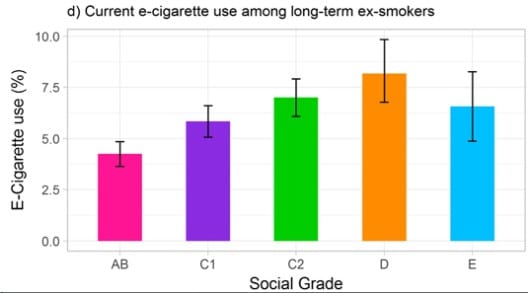E-cigarettes – a tool to reduce inequalities in smoking?
By guest blogger, on 19 February 2019
 Since their arrival in the UK in 2010/11, electronic cigarettes (e-cigarettes or vapes) have rapidly become the most popular aid to help people quit smoking. With evidence continuing to grow showing that vaping 1) poses a small fraction of the risks of smoking and 2) improves smoking quit success, Public Health England have restated that smokers who are struggling to quit should ‘try switching to an e-cigarette’ along with seeking help by trained specialists. But what does this mean for existing inequalities in smoking?
Since their arrival in the UK in 2010/11, electronic cigarettes (e-cigarettes or vapes) have rapidly become the most popular aid to help people quit smoking. With evidence continuing to grow showing that vaping 1) poses a small fraction of the risks of smoking and 2) improves smoking quit success, Public Health England have restated that smokers who are struggling to quit should ‘try switching to an e-cigarette’ along with seeking help by trained specialists. But what does this mean for existing inequalities in smoking?
Following a steady decline over the past decade, 15% of the population in England are estimated to currently smoke. However, smoking rates fall along a social gradient, with one in four people from disadvantaged socio-economic groups smoking, compared with one in ten from more affluent groups. This means that a disproportionate number of the ~78,000 deaths and the ~485,000 hospital admissions caused by smoking in England each year fall upon the disadvantaged.
Given their popularity (used by >30% of smokers making a quit attempt) and generally lower cost compared with cigarettes, e-cigarettes have potential to help reduce inequalities in smoking cessation. However, a concern during the early period in which e-cigarettes first arrived on the UK market was that they were more popular with better off smokers. If the devices boost quit success, which appears to be the case, then these differences in use across the social gradient could potentially lead to disadvantaged smokers being left behind, thus worsening the existing inequalities.
Keeping up with change
Since their creation in 2003 by a Chinese pharmacist Hon Lik, e-cigarettes have continued to evolve with novel designs and more effective nicotine delivery systems being rolled out each year. The Smoking Toolkit Study (STS), set up by the Tobacco and Alcohol Research Group at UCL to monitor population trends in smoking in England, is one way that researchers and policy makers can keep up with this ever-changing landscape of e-cigarette use and assess whether they promote or detract from reducing smoking rates.
Using STS data from 2014 to 2017, our recent research published in the journal Addiction was the first of kind to look at the use of e-cigarettes by different socio-economic groups at the population level. Our study analysed data from over 81,000 adults in England, including 16,000 past-year smokers, 5,300 smokers making a quit attempt and 13,500 long-term ex-smokers. E-cigarette use in each group was assessed using participant social grade (based on occupation) or housing status as key indicators of socio-economic position.
Narrowing differences among smokers
Our analysis indicated that in the three years from 2014 to 2016, disadvantaged smokers were around half as likely to use e-cigarettes. However, by 2017 this difference was no longer evident. Similarly, there were no differences in e-cigarette use by smokers making a quit attempt. Should this absence of difference between socioeconomic groups remain going forward then it is unlikely that the use of e-cigarettes among smokers and quit attempters will have a persistent impact on inequalities. However, it will be important to investigate whether there are socio-economic differences in the success of quit attempts with e-cigarettes, something which researchers in our group have been looking into.
Greater e-cigarette use among disadvantaged ex-smokers
Our research also showed a different pattern among smokers who had been quit for over a year, with disadvantaged ex-smokers more than twice as likely to use an e-cigarette. This could have important implications, and really depends on whether e-cigarettes prevent ex-smokers from relapsing back into smoking tobacco. If that were true (unfortunately there isn’t much research on this yet) then e-cigarette use would protect more disadvantaged smokers from slipping back into smoking and act to reduce inequalities; an equity-positive effect.
The wider picture
Inequalities in smoking are driven by a complex and nuanced system acting at the population, community and individual level. Reducing disparity requires action at all levels such as tobacco taxes, public health media and education campaigns and individual specialist support that targets the neurobiological and motivational components of nicotine addiction that dependent smokers struggle with. E-cigarettes are not a magic wand for quitting smoking. Rather, given their popularity and similar effectiveness to other forms of nicotine replacement therapy, they are part of a toolbox of interventions that are contributing to the continuing decline in smoking in the UK. If they are available, affordable and able to deliver nicotine effectively without the loss of social identity that some smokers subscribe to, e-cigarettes may also help redress the persistent inequalities in smoking.
Loren Kock (@loren_kock.) is a Cancer Research UK funded PhD student in Epidemiology and Public health, working within the UCL Tobacco and Alcohol Research Group. His research focusses on how e-cigarettes and other smoking cessation interventions impact on socio-economic inequalities in smoking cessation.
 Close
Close


